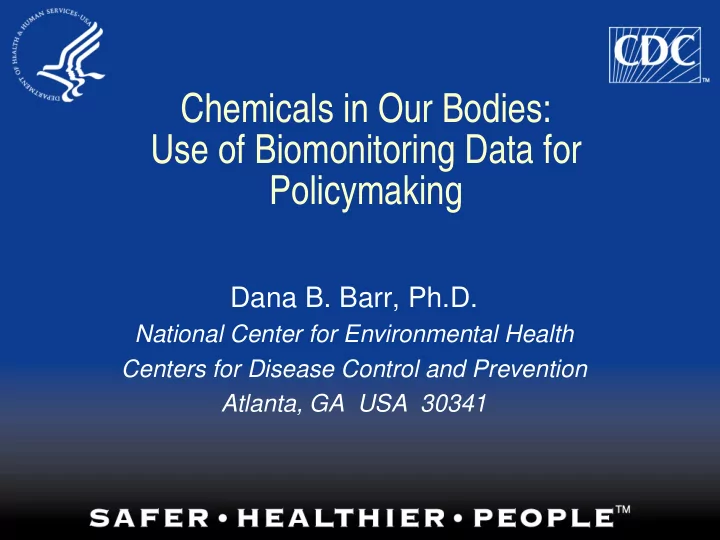

Chemicals in Our Bodies: Use of Biomonitoring Data for Policymaking Dana B. Barr, Ph.D. National Center for Environmental Health Centers for Disease Control and Prevention Atlanta, GA USA 30341
How can we assess exposure? Source Water, Air, Food, Soil, Dust, Sediment, Personal Care Products Exposure Inhalation A bsorption following: Ingestion Dermal Internal Dose Contact M etabolism D istribution E limination Target E limination Organ Dose Biologically Effective Dose P harmacodynamic Processes Effect Angerer et al., Toxicol Sci. 93(1):3-10 (2006).
What is human biomonitoring? � Measuring a chemical, its metabolite or reaction product in human matrices � Estimates absorbed dose � Does not measure exposure
Why is Biomonitoring Important? � Provides information about what chemicals get into people � Can provide information on the effectiveness of exposure mitigation efforts � Can be used in studies evaluating health effects � Can help direct our research priorities � May be used to estimate exposure
History of Biomonitoring � 1880s Occupational monitoring � 1980s Selected “exposed” population � 1990s General population exposures � 2000s Large scale studies – Epidemiologic studies – General population
Biomonitoring Today � Advances in chemistry techniques have allowed us to measure more chemicals at lower levels � For most chemicals, we have an incomplete framework for interpreting the measurements � Measurable levels do not mean disease is present or will occur � Cannot tell how one was exposed to the chemical � Does not provide information on how to reduce exposures
CDC’s Biomonitoring Program � Currently largest population- based study � Human matrices are blood and urine � General Population � CDC’s National Reports on Human Exposure to Environmental Chemicals � Large volume of data � Some data are more useful than others: chemical specific www.cdc.gov/exposurereport
Blood lead levels in US population (1976-2002) 110 18 Lead used in gasoline (1000 tons) 16 Blood lead levels ( µ g/dL) 14 lead soldered cans, phase-out begins 1978 lead 12 paint ban 1976 10 lead & leaded copper 8 gas rule unleaded removal 1991 gasoline complete 6 introduced 1991 lead soldered 1975 cans, phase-out 4 ends 1992 2 0 1976 1980 1984 1988 1992 1996 2000 2004 Year
Serum Cotinine in the US Population (1988-1991) 5 Percentage of the population ETS exposure Smokers 4 (nonsmokers) 3 2 1 0 0.1 1.0 10 100 1000 Serum cotinine (ng/mL)
Serum Cotinine (1988-1991) 1.6 Geometric mean serum cotinine (ng/mL) 1.4 1.2 1.0 0.8 0.6 0.4 0.2 0.0 0 1 ≥ 2 Number of smokers in the home
1988-1991 1999-2002 75% 20-74 Reduction in Serum Cotinine 69% Age (years) 12-19 68% 4-11 0 0.3 0.2 0.1 Serum cotinine (ng/mL)
Biomonitoring Usefulness � Useful for chemicals that biologically persist � Useful for chemicals to which we are exposed continually or continuously � More difficult to use for chemicals to which we are temporally or intermittently exposed � More difficult when the chemical we measure is not the parent chemical
Recommend
More recommend